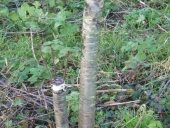posted 7 years ago
Hi vin.
As mentioned, trees being grafted need to be compatible with eachother. This usually means being different cultivars of the same species, although I think that most stone fruit can be grafted with other stonefruit, though I have to check on that one. I know, as well, that pear can be grafted onto hawthorn, but again, the reason is genetic compatibility.
Nathaniel's point about grafting by itself not yielding a food forest is right on the mark. Whatever you could graft onto the almond would need to be so closely related that you wouldn't be encouraging genetic diversity.
I like the idea of converting old orchard of any kind to food forest. I would thin the orchard for space and airflow, and at the appropriate time, prune the remaining trees as necessary. I would plan a multi-trophic polyculture, occupying all of the niches possible, from tuber, groundcover, and different levels of soft green undergrowth to woody shrubbery, other fruit trees, vines, understory fruit and nut trees, and finally a long-maturing overstory tree, probably producing mast of some sort.
I would also plan mine as rows of food forest separating alleys of either grazing or no-till field crops. If there was a slope, the trees kept would be on contour.
In your case, I would see what different species might grow well in the same conditions as the almond. A temperate food forest won't look anything like a tropical one, after all. Where are you located?
In any case, good luck, and keep us posted.
-CK
A human being should be able to change a diaper, plan an invasion, butcher a hog, conn a ship, design a building, write a sonnet, balance accounts, build a wall, set a bone, comfort the dying, take orders, give orders, cooperate, act alone, solve equations, analyze a new problem, pitch manure, program a computer, cook a tasty meal, fight efficiently, die gallantly. Specialization is for insects.
-Robert A. Heinlein







